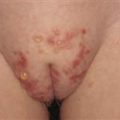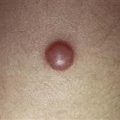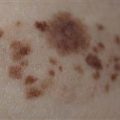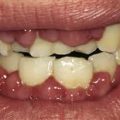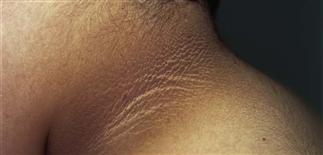
Acanthosis nigricans on overweight preteen’s neck.

Acanthosis nigricans of teen’s axilla.
CLINICAL FEATURES
Hyperpigmentation of folds of skin on the posterior neck, axillae and groin characterize acanthosis nigricans. AN is predominantly seen in overweight dark-skinned preteens and teens. The surface of the hyperpigmented areas feels soft and velvety and multiple small 1–2-mm skin tags may be found within involved skin. Sometimes, additional skin areas such as elbows, areolae and knuckles are involved. Parents often complain that the skin is ‘dirty’ and cannot be washed off. AN is strongly associated with obesity and insulin resistance. Less commonly, it is associated with endocrinopathies such as Cushing’s disease or acromegaly, in lipoatrophy, Prader–Willi syndrome, leprechaunism and craniofacial syndromes that have mutations in the bFGF receptor.
TREATMENT
In overweight teens with AN, improvement has occurred with weight loss, regular exercise and the use of low-dose oral metformin. With endocrinopathy-associated AN, correction of the endocrinopathy will help.

